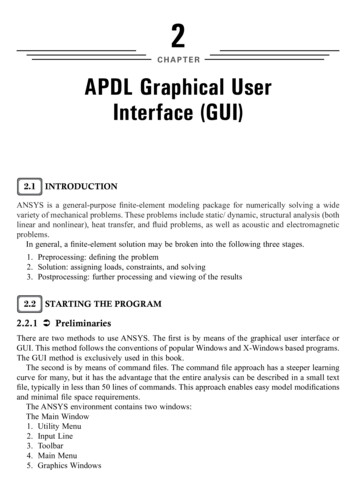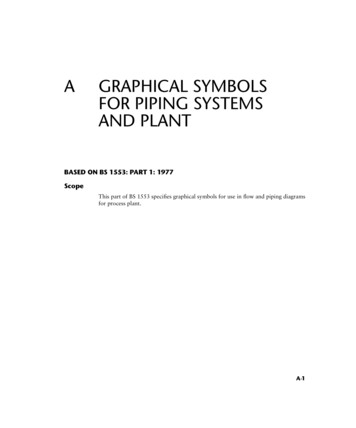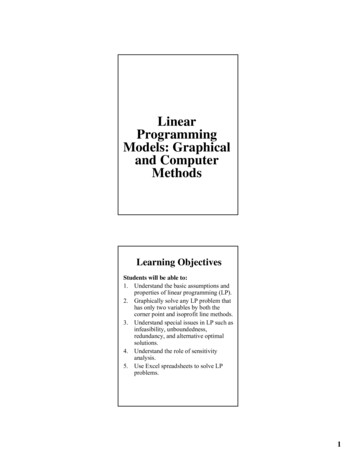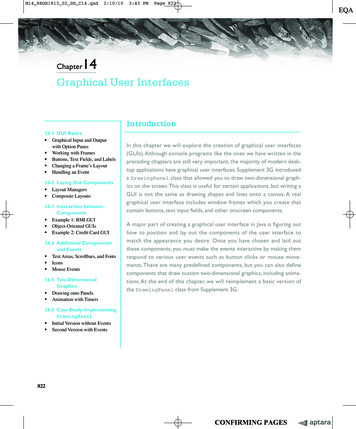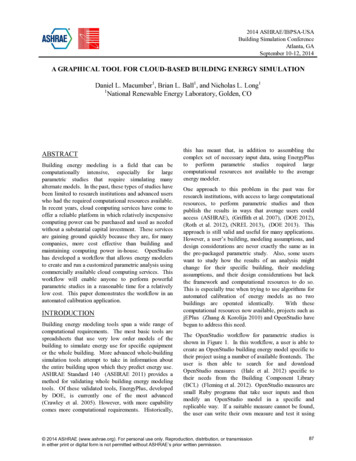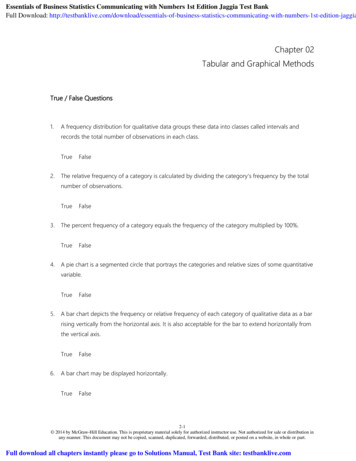
Transcription
Essentials of Business Statistics Communicating with Numbers 1st Edition Jaggia Test BankFull Download: ition-jaggiaChapter 02Tabular and Graphical MethodsTrue / False Questions1.A frequency distribution for qualitative data groups these data into classes called intervals andrecords the total number of observations in each class.True2.FalseThe relative frequency of a category is calculated by dividing the category's frequency by the totalnumber of observations.True3.The percent frequency of a category equals the frequency of the category multiplied by 100%.True4.FalseFalseA pie chart is a segmented circle that portrays the categories and relative sizes of some quantitativevariable.True5.FalseA bar chart depicts the frequency or relative frequency of each category of qualitative data as a barrising vertically from the horizontal axis. It is also acceptable for the bar to extend horizontally fromthe vertical axis.True6.FalseA bar chart may be displayed horizontally.TrueFalse2-1 2014 by McGraw-Hill Education. This is proprietary material solely for authorized instructor use. Not authorized for sale or distribution inany manner. This document may not be copied, scanned, duplicated, forwarded, distributed, or posted on a website, in whole or part.Full download all chapters instantly please go to Solutions Manual, Test Bank site: testbanklive.com
7.To approximate the width of a class in the creation of a bar chart, we may use this formula:True8.FalseFor quantitative data, a cumulative frequency distribution records the number of observations thatfall below the upper limit of each class.True9.FalseFor quantitative data, a cumulative relative frequency distribution records the proportion (fraction)of values that fall below the upper limit of each class.TrueFalse10. A histogram is a series of rectangles where the width and height of each rectangle represent thefrequency (or relative frequency) and the width of the class, respectively.TrueFalse11. A polygon connects a series of neighboring points where each point represents the midpoint of aparticular class and its associated frequency or relative frequency.TrueFalse12. An ogive is a graph that plots the cumulative frequency (or the cumulative relative frequency) ofeach class above the lower limit of the corresponding class.TrueFalse13. A stem-and-leaf diagram is useful in that it gives an overall picture of where quantitative data arecentered and how the data are dispersed from the center.TrueFalse2-2 2014 by McGraw-Hill Education. This is proprietary material solely for authorized instructor use. Not authorized for sale or distribution inany manner. This document may not be copied, scanned, duplicated, forwarded, distributed, or posted on a website, in whole or part.
14. A scatterplot is a graphical tool that helps determine whether or not two quantitative variables arerelated.TrueFalse15. When constructing a scatterplot for two quantitative variables, we usually refer to one variable as xand another one as y. Typically, we graph x on the vertical axis and y on the horizontal axis.TrueFalseMultiple Choice Questions16. Frequency distributions may be used to describe which of the following types of data?A. Nominal and ordinal data onlyB. Nominal and interval data onlyC. Nominal, ordinal, and interval data onlyD. Nominal, ordinal, interval, and ratio data17. In order to summarize qualitative data, a useful tool is a .A. histogramB. frequency distributionC. stem-and-leaf diagramD. All of the Answers2-3 2014 by McGraw-Hill Education. This is proprietary material solely for authorized instructor use. Not authorized for sale or distribution inany manner. This document may not be copied, scanned, duplicated, forwarded, distributed, or posted on a website, in whole or part.
18. For both qualitative and quantitative data, what is the difference between the relative frequencyand the percent frequency?A. The relative frequency equals the percent frequency multiplied by 100.B. The percent frequency equals the relative frequency multiplied by 100.C. As opposed to the relative frequency, the percent frequency is divided by the number ofobservations in the data set.D. As opposed to the percent frequency, the relative frequency is divided by the number ofobservations in the data set.19. For which of the following data sets will a pie chart be most useful?A. Heights of high school freshmenB. Ambient temperatures in the U.S. Capitol BuildingC. Percentage of net sales by product for Lenovo in 2011D. Growth rates of firms in a particular industry2-4 2014 by McGraw-Hill Education. This is proprietary material solely for authorized instructor use. Not authorized for sale or distribution inany manner. This document may not be copied, scanned, duplicated, forwarded, distributed, or posted on a website, in whole or part.
20. Exhibit 2-1.An auto parts chain asked customers to complete a survey rating the chain's customer service asaverage, above average, or below average. The following shows the results from the survey:Refer to Exhibit 2-1. The proportion of customers that felt the customer service was average isclosest to .A. 0.20B. 0.33C. 0.46D. 0.532-5 2014 by McGraw-Hill Education. This is proprietary material solely for authorized instructor use. Not authorized for sale or distribution inany manner. This document may not be copied, scanned, duplicated, forwarded, distributed, or posted on a website, in whole or part.
21. Exhibit 2-1.An auto parts chain asked customers to complete a survey rating the chain's customer service asaverage, above average, or below average. The following shows the results from the survey:Refer to Exhibit 2-1. A rating of Average or Above Average accounted for what number ofresponses to the survey?A. 3B. 7C. 8D. 1022. Exhibit 2-2.The following is a list of five of the world's busiest airports by passenger traffic for 2010.Refer to Exhibit 2-2. The percentage of passenger traffic in the five busiest airports that occurred inAsia is closest to .A. 18%B. 21%C. 25%D. 38%2-6 2014 by McGraw-Hill Education. This is proprietary material solely for authorized instructor use. Not authorized for sale or distribution inany manner. This document may not be copied, scanned, duplicated, forwarded, distributed, or posted on a website, in whole or part.
23. Exhibit 2-2.The following is a list of five of the world's busiest airports by passenger traffic for 2010.Refer to Exhibit 2-2. How many more millions of passengers flew out of Atlanta than flew out ofChicago?A. 13B. 21C. 23D. 252-7 2014 by McGraw-Hill Education. This is proprietary material solely for authorized instructor use. Not authorized for sale or distribution inany manner. This document may not be copied, scanned, duplicated, forwarded, distributed, or posted on a website, in whole or part.
24. Exhibit 2-3.A city in California spent six million dollars repairing damage to its public buildings in 2010. Thefollowing table shows the categories where the money was directed.Refer to Exhibit 2-3. How much did the city spend to fix damage caused by mold?A. 360,000B. 720,000C. 1,440,000D. 1,800,0002-8 2014 by McGraw-Hill Education. This is proprietary material solely for authorized instructor use. Not authorized for sale or distribution inany manner. This document may not be copied, scanned, duplicated, forwarded, distributed, or posted on a website, in whole or part.
25. Exhibit 2-3.A city in California spent six million dollars repairing damage to its public buildings in 2010. Thefollowing table shows the categories where the money was directed.Refer to Exhibit 2-3. How much more did the city spend to fix damage caused by termitescompared to the damage caused by water?A. 360,000B. 720,000C. 960,000D. 1,320,0002-9 2014 by McGraw-Hill Education. This is proprietary material solely for authorized instructor use. Not authorized for sale or distribution inany manner. This document may not be copied, scanned, duplicated, forwarded, distributed, or posted on a website, in whole or part.
26. Exhibit 2-4.Students in Professor Smith's Business Statistics course have evaluated the overall effectiveness ofthe professor's instruction on a five-point scale, where a score of 1 indicates very poor performanceand a score of 5 indicates outstanding performance. The raw scores are displayed in theaccompanying table:Refer to Exhibit 2-4. What is the most common score given in the evaluations?A. 2B. 3C. 4D. 527. Exhibit 2-4.Students in Professor Smith's Business Statistics course have evaluated the overall effectiveness ofthe professor's instruction on a five-point scale, where a score of 1 indicates very poor performanceand a score of 5 indicates outstanding performance. The raw scores are displayed in theaccompanying table:Refer to Exhibit 2-4. What percentage of students gave Professor Smith an evaluation higher than3?A. 20%B. 30%C. 50%D. 80%2-10 2014 by McGraw-Hill Education. This is proprietary material solely for authorized instructor use. Not authorized for sale or distribution inany manner. This document may not be copied, scanned, duplicated, forwarded, distributed, or posted on a website, in whole or part.
28. Exhibit 2-4.Students in Professor Smith's Business Statistics course have evaluated the overall effectiveness ofthe professor's instruction on a five-point scale, where a score of 1 indicates very poor performanceand a score of 5 indicates outstanding performance. The raw scores are displayed in theaccompanying table:Refer to Exhibit 2-4. What percentage of students gave Professor Smith an evaluation of 2 or less?A. 6.7%B. 13.3%C. 20%D. 80%29. Exhibit 2-4.Students in Professor Smith's Business Statistics course have evaluated the overall effectiveness ofthe professor's instruction on a five-point scale, where a score of 1 indicates very poor performanceand a score of 5 indicates outstanding performance. The raw scores are displayed in theaccompanying table:Refer to Exhibit 2-4. What is the relative frequency of the students who gave Professor Smith anevaluation of 3?A. 0.3B. 0.5C. 9D. 152-11 2014 by McGraw-Hill Education. This is proprietary material solely for authorized instructor use. Not authorized for sale or distribution inany manner. This document may not be copied, scanned, duplicated, forwarded, distributed, or posted on a website, in whole or part.
30. In the following pie chart representing a collection of cookbooks, which author has more titles?A. Jeff SmithB. Julia ChildC. Rachael RayD. Paula Deen2-12 2014 by McGraw-Hill Education. This is proprietary material solely for authorized instructor use. Not authorized for sale or distribution inany manner. This document may not be copied, scanned, duplicated, forwarded, distributed, or posted on a website, in whole or part.
31. The accompanying chart shows the numbers of books written by each author in a collection ofcookbooks. What type of chart is this?A. Bar chart for qualitative dataB. Bar chart for quantitative dataC. Frequency histogram for qualitative dataD. Frequency histogram for quantitative data2-13 2014 by McGraw-Hill Education. This is proprietary material solely for authorized instructor use. Not authorized for sale or distribution inany manner. This document may not be copied, scanned, duplicated, forwarded, distributed, or posted on a website, in whole or part.
32. The accompanying chart shows the number of books written by each author in a collection ofcookbooks. What type of data is being represented?A. Quantitative, ordinalB. Quantitative, ratioC. Qualitative, nominalD. Qualitative, ordinal33. Horizontal bar charts are constructed by placing:A. each category on the vertical axis and the appropriate range of values on the horizontal axis.B. each category on the horizontal axis and the appropriate range of values on the vertical axis.C. each interval of values on the vertical axis and the appropriate range of values on the horizontalaxis.D. None of the Answers.2-14 2014 by McGraw-Hill Education. This is proprietary material solely for authorized instructor use. Not authorized for sale or distribution inany manner. This document may not be copied, scanned, duplicated, forwarded, distributed, or posted on a website, in whole or part.
34. When constructing a frequency distribution for quantitative data, it is important to remember that.A. classes are mutually exclusiveB. classes are collectively exhaustiveC. the total number of classes usually ranges from 5 to 20D. All of the Answers35. Which of the following best describes a frequency distribution for qualitative data?A. It groups data into histograms and records the proportion (fraction) of observations in eachhistogram.B. It groups data into categories and records the number of observations in each category.C. It groups data into intervals called classes and records the proportion (fraction) of observationsin each class.D. It groups data into intervals called classes and records the number of observations in each class.36. What graphical tool is best used to display the relative frequency of grouped quantitative data?A. OgiveB. Pie chartC. Bar chartD. Histogram2-15 2014 by McGraw-Hill Education. This is proprietary material solely for authorized instructor use. Not authorized for sale or distribution inany manner. This document may not be copied, scanned, duplicated, forwarded, distributed, or posted on a website, in whole or part.
37.Exhibit 2-5.The following data represent scores on a pop quiz in a statistics section:Refer to Exhibit 2-5. Suppose the data on quiz scores will be grouped into five classes. The widthof the classes for a frequency distribution or histogram is closest to .A. 10B. 12C. 14D. 1638.Exhibit 2-5.The following data represent scores on a pop quiz in a statistics section:Refer
Students in Professor Smith's Business Statistics course have evaluated the overall effectiveness of the professor's instruction on a five-point scale, where a score of 1 indicates very poor performance and a score of 5 indicates outstanding performance. The raw scores are displayed in the accompanying table: Refer to Exhibit 2-4. What is the most common score given in the evaluations? A. 2 B .
